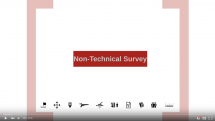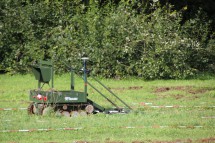A TIRAMISU robot to take centre stage at the 2015 Humanitarian Robotics and Automation Technology Challenge
An Unmanned Ground Vehicle (UGV) developed in the context of the TIRAMISU project will be used in next year’s Humanitarian Robotics and Automation Technology Challenge (HRATC’15) as the “playing field” on which the competing teams will test their coding and their robotic command skills.
The second Humanitarian Robotics and Automation Technology Challenge (HRATC) will take place between the 26th and the 28th of May 2015, in the context of the International Convention on Robotics and Automation (ICRA) at the Washington State Convention Centre in Seattle, USA.
A robotics platform developed by a team from the Institute of Systems and Robotics (ISR) at the University of Coimbra, Portugal will form the backbone of next year’s challenge.
The IEEE Robotics and Automation Society‘s Special Interest Group on Humanitarian Technology
(RAS-SIGHT) organised the upcoming edition of HRATC with a special focus on promoting the development of new strategies for autonomous landmine detection using a mobile (ground) robot.
The HRATC challenge has two phases: a simulation phase, during which the teams prepare their code to be run on a simulator, and a second phase, which involves a set of tests to assess the teams’ ability to operate the robot remotely. During the competition, the teams will send their code to be run on the ISR UGV in Portugal, and the results will be displayed in real time at the ICRA 2015 venue in the USA.
The strategies developed by the participating teams will be objectively and quantitatively evaluated according to the following criteria: exploration time and coverage (to assess the efficiency of the operation), detection and classification quality, (i.e. the accurate categorisation of metallic objects as either a landmine or non-landmine) and landmine avoidance.
Teams will be progressively eliminated after each phase of the competition and the remaining teams will move on to the next phase culminating in the Challenge (Finals) phase at ICRA'15.
Thanks to the common use of the platform provided by TIRAMISU, participating teams do not need to purchase or build a robot equipped with sensors or procure any of the accompanying software.
The UGV that will be used in the challenge was developed by ISR, in the context of the TIRAMISU project, which aims to provide the Mine Action community with a toolbox to assist them in tackling the social and humanitarian issues associated with landmines.
According to the UN Mine Action Service, landmines kill 15,000-20,000 people every year (mostly children) and maim countless more across 78 countries. Demining efforts cost 300-1000 US dollars per mine, and, for every 5,000 mines cleared, one person is killed and two are injured. Thus, mine clearance in post-conflict regions has proven to be a difficult, risky, dangerous and expensive task with enormous social implications for civilians. Therefore, the development and exploitation of robotic devices capable of carrying out mine removal activities is essential for reducing the human cost of landmines.
Read More:
http://www.ieee-ras.org/educational-resources-outreach/humanitarian-efforts/
http://www.isr.uc.pt/HRATC2015
http://icra2015.org/conference/robot-challenges




